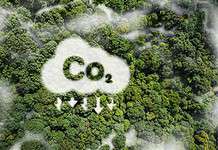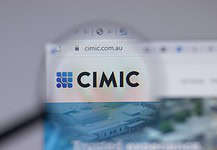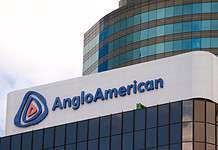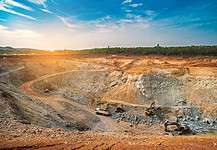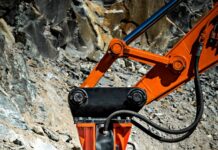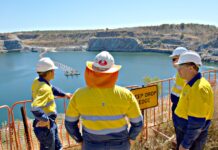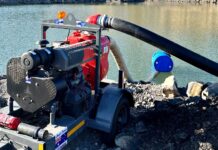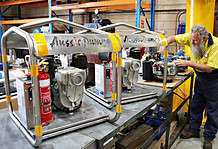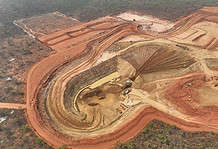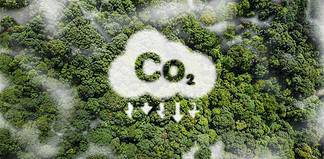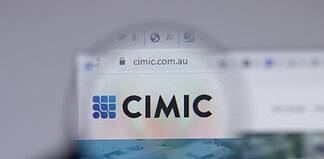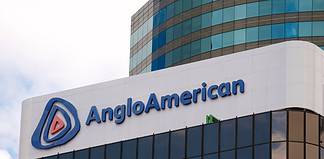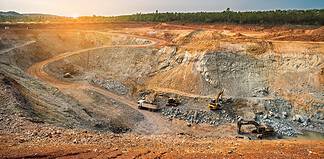All images: Image Resources.
BY REUBEN ADAMS
THE mineral sands market continues to tighten in 2018 with prices increasing as a result – particularly in zircon. It’s in this positive pricing environment that Image Resources is fast-tracking development of its high-grade, zircon-rich flagship Boonanarring mineral sands project, 80km north of Perth, WA.
Boonanarring is considered one of the highest-grade mineral sands projects in Australia – and about 70 per cent of revenue will come from zircon. The low capital cost, short lead time to production and strong forecast cash flow, coupled with multiple growth options positions Image as an exciting new player in the mineral sands space.
Reuben Adams spoke with Image managing director Patrick Mutz.
Q. A recent article noted that many explorers often struggle to make that quantum leap to production on their own – something Image has almost achieved. What learnings have you applied to Boonanarring from your time as Murray Zircon chief?
I suppose the biggest lesson is to develop a credible plan, which includes full project or company funding; get full support from the Board on the plan; and then most importantly, “work the plan”.
Q. What are some of the key mistakes junior companies make during this transition to production?
Perhaps one of the biggest mistakes is for the company failing to recognise that the transition to production is best done by a team with specific project development and production experience, rather than by members of the exploration team without those skills and experience.
No criticism whatsoever to the exploration team. They are great at what they do, but the learning curve of carrying the ball through the project development phase will at best be less efficient and more costly to the company, and at worse could result in a failed transition.
Q. Boonanarring has been on the fast track to development since the series of transactions with Murray Zircon mid-2016. How did the initial discussions between the companies come about?
I was fortunate to have had to opportunity to start those discussions between the companies back in mid-2014.
The idea from the outset was to bring together Image Resources (with a great set of high-grade and zircon-rich mineral sand resources and ore reserves in the ground, but with no operational equipment or experience) and Murray Zircon (a company with all the necessary equipment and operational expertise, but with only lower grade mineral sand resources in the ground), in such a manner that 1 plus 1 was greater than 2.
The combination of Murray Zircon’s equipment and experience gave Image a major advantage to fast-track the project to production while the mineral sands commodity prices were still at their lowest level in some eight years.
And, by doing so, Image will now be in pole position to capitalise on the rapidly rising zircon prices that are forecast to continue to rise through 2022.
Q. The main reason for the low $52m project capex was the prior acquisition of key capital equipment, including the Wet Concentration Plant in the Murray Zircon deal. How much did you save in estimated capital costs?
It is not easy to estimate how much this may have saved Image, however it can be argued that in the first instance the replacement cost for this equipment would have been between $25m and $30m.
However, there is also the element of time savings. For example, construction and commissioning time are significantly reduced by utilising the wet concentration plant (WCP) from Murray Zircon’s Mindarie mineral sands project in South Australia, which results in not so much a ‘construction’ project, but rather an equipment relocation and reassembly project.
The WCP and associated equipment from Murray Zircon is a pre-engineered, pre-commissioned, proven assembly of equipment. These latter positive issues are more difficult to place a value contribution to for Image, but they are real.
Q. How is relocation of the WCP and associated equipment from South Australia tracking?
By the end of June 2018, the WCP and associated equipment will have been almost completely relocated from South Australia to the Boonanarring project site, some 80km north of Perth and be already partially reassembled.
Q. How is the aggressive construction schedule tracking?
As of the end of June 2018, we are three months into a six to seven month construction period, and thus far, we are on track and on budget.
This has always been an aggressive schedule, and it is clearly seeing its challenges.
To our credit, we have selected a project management team and contractors with specific experience for this type of build, but most importantly, with a “get-it-done” attitude while maintaining a safe, environmentally-friendly and land-owner and community sensitive approach.
Q. The original BFS estimated a rapid debt payback period of 22 months. Do you intend to pay down this debt pile even sooner if benchmark zircon prices continue to climb, or will you use this extra cash elsewhere?
The original BFS results published in May 2017 indeed indicated a payback period of just 22 months.
However, the BFS was revised in November 2017, with higher commodity prices and a different AUD:USD foreign exchange rate curve, and resulted in a payback period of only 16 months.
That aside, the $50m debt package we executed does not allow an early repayment of the loan. Therefore the extra cash generated during the three year term of the loan will partially be used to fund additional exploration aimed at increasing ore reserves and therefore the mine life at Boonanarring, as well as potentially a scoping study to determine the preliminary economics of a second operating mining centre at one of Image’s other projects called Bidaminna, just 25km northwest of Boonanarring.
Q. What is the next focus for Image once Boonanarring is up and running?
Once we demonstrate profitable operations at Boonanarring, Image will be evaluating its options to grow the company. Importantly, we have a few options within our current, 100 per cent owned portfolio of projects in the West Perth Basin.
The first priority will be to add ore reserves at Boonanarring and in the immediate area around the processing plant to expand the effective mine life to 10 years or more.
Next will be to investigate the possibility of a second operation mining centre, with the front-runner prospect at this time being the Bidaminna project, which has the potential to become a stand-alone dredge mining project.
Of course, the company will also be looking at the opportunity to also offer a dividend following the repayment of the three-year debt facility.
Q. How did your discussions with Sunrise Energy Group initially come about? What are some of the key benefits the solar farm will bring to the operation?
Since the Boonanarring project is located in an infrastructure-rich part of the North Perth Basin just 80km north of Perth, we have the opportunity to tie in to grid power.
The project is not in a remote location so, to be honest, solar was not on my radar screen. Sunrise Energy Group actually approached Image with the opportunity to utilise solar.
As the cost of solar equipment continues to come down, Sunrise was able to put an offer on the table for Image to utilise solar for the Boonanarring processing plant on an economic basis, and without the need for additional capital.
I call this a “no-brainer”.
Image is able to do the right thing by the environment and community – at no up-front cost, and with a small but significant annual savings – by simply agreeing to take electricity supply from the solar farm.
Obviously I am being a bit overly simplistic, but the fact is, solar has now become economically competitive for industrial users, and it comes with the benefit of perhaps an intangible, but none-the-less important green footprint.


